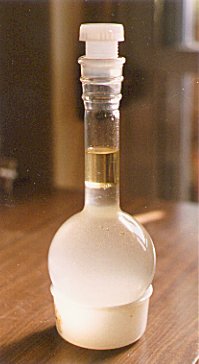Distillation of Essential Oils
For the distillation of essential oils, you will have to use a 6-litre
alembic with a 2-litre recipient with high neck.
It will be unnecessary to tell you that the essential oils can only be
distilled from plants that possess it, such like Rosemary (Rosmarinus Officinalis),
Anisette (Pimpenela Anisium), Cypress (Cupressus Sempervirens),
Camomile, (Anthemis Nobilis), Eucalyptus (Eucaliyptus Globulus), Mint (Menta
Piperita), Lavender (Lavendula Officinalis), Pennyroyal (Menta Pulegium),
Thyme (Thymus Vulgaris), etc.
For you "to become handy at it", we recommended to distil the
Eucalyptus plant, because it is very easy to get the oils from it, as well as for the
amount of essential oil that it contains. The leaves of the adult branches contain 1,2 to
3% of essential oil.
Cut some branches of Eucalyptus and remove the leaves, one by one. Put
them in an alembic until it reaches the height of the neck of the cucurbit. Place the
cucurbit on an oven and, pour onto the leaves 3 litre of water the source.
Place the thermometer, the protection cone and, finally, the helm after
you have applied silicon on all the joints. Adapt to the beak a reducer with air hole and
this one to a matrass (receiver) with plane bottom having a neck of more than a transverse
hand of height.
First, heat up to a moderate temperature, of about 50 degrees C, for
the space of one hour and, only then, will you increase the temperature to about 100
degrees C.
After some time, you will notice, inside the helm, tiny globules of
essential oil that will run down the throat towards the beak and in to the recipient
together with the distilled water.
Continue to distil uninterrupted, to the same temperature, but having
the caution of verifying if the helm doesn't heat up too much. If it becomes so warm that
you could not place your hand on the top, then reduced the temperature.

When the distillation reaches more than half of the height of the belly
of the recipient, you can observe a thin oleaginous layer upon the water, with the
thickness of 2 or 3 mm. Continue the
distillation until the essential oil reaches about half of the receiver's neck. Then,
turn off the oven. With the remaining temperature, your distillation will reach the top of
the recipient.
Observe that the essential oil doesn't surpass the upper level of the
receiving vase, because, if that happens, the oil will get lost through the air hole of
the adapter.
You will have distilled 20 or 30 ml of essential oil that you will
remove through the recipient neck with a syringe, and keep in a glass flask tightly closed
and sheltered from the light.
Instead of the long neck recipient, you can also use a separator for
essential oil.
Leave your alembic to cool down and remove the helm. Remove the
cucurbit from the oven and, with a hook of very strong wire, remove all of the eucalyptus
leaves from the cucurbit.
Repeat the process again, using the distilled water that was in the
recipient, being, just necessary to increase to more than 1 litre.
The same process will be applied to all the other plants that contain
essential oils. It is evident that not all plants have the same amount of oil, and that
the revenue will be different for each plant, although the extraction process will always
be the same.
Pay attention that you don't evaporate all of the water in the
cucurbit so that the plants don't burn. If that happened, the essential oil would go out
with empyreuma, what would be very unpleasant. If you pour 3 litre of water in the alembic
and distil 2, it wills leave 1 litre in the cucurbit.
Evidently there are other distillation to expedite the process and that
give larger revenue as it is with a 100 litre stainless steel cucurbit or plus, equipped
with a flowing back column refrigerated and an oil separator. But this system is out of
the ambit of our spagyrics and it is only used in factory.
Rubellus Petrinus
@nifo@innergarden.org
Inner Garden Foundation
P.O. Box 8520, 3542AD
Utrecht, The Netherlands